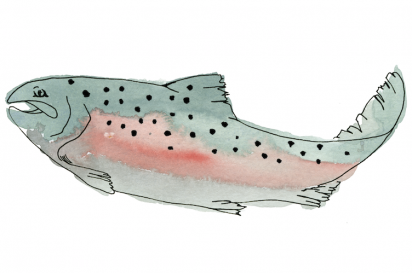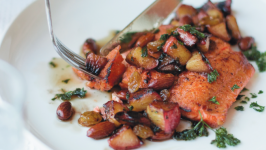Getting Hooked on Salmon
Every year come mid-May, in south central Alaska, there is a massive exodus. But it’s not snowbirds vacating their homes in search of warmer weather—I mean, why would they leave when the temperature is teetering near 60? Mild by Midwest standards, but darn near sauna-like for Alaskans. Still, the exodus happens … and it’s been happening at the same time every year since the Ice Ages.
The rise and fall of the king
Alaska’s Prince William Sound is home to the Copper River—a glacial-fed river with a nearly 35-mile-wide gorge where the river dumps over 500,000 cubic feet of water per second into the Gulf of Alaska, and where thousands of young salmon leave their birthplace in the Copper to feed at sea for the next few years. Then, some two to seven years later, the now-adult salmon leave the Gulf to make their 300-mile-long journey home to spawn—an arduous task fueled by their high concentration of omega-3 fatty acids, an inimitable trait that makes salmon, especially those from the Copper River, one of the most coveted of all seafoods, worldwide.
The Copper River produces three types of salmon: king (aka Chinook), sockeye and coho. All three can come with a price tag more than double that of the same species from other locations—the king landing the highest price at $35–40 a pound. But it wasn’t always like this. Thirty years ago, most Copper River salmon was sold to Japan, where demand was (and still is) high but export prices were excruciatingly low. So low that many fishermen docked their boats in search of more lucrative, land-based occupations. Nowadays, thanks in part to what many call savvy marketing and brilliant PR, the catch from the Copper is one of the most profitable in the country, let alone the world. But unfortunately, there’s a declining population as fewer and fewer salmon are returning home to spawn and the ones that do make it home are nearly 20 percent smaller than in previous years.
Last year, the commercial season’s first opener on the Copper—which lasted all of 12 hours—only brought in about 1,500 kings and 25,000 sockeye and their average size was the lowest in 50 years. In January of this year, the Alaska Department of Fish and Game (ADFG) forecast this year’s king salmon run to be the smallest since 1980, prompting a March decision to close all king salmon sport fisheries in the Upper Copper River. Come mid-May, the ADFG will decide whether the Copper will have a commercial season for king salmon.
The case for sustainable fishing
Years of overfishing and unsustainable practices have certainly hurt the fishing industry as a whole, but there are many physical and biological reasons for the diminishing salmon population, including urban development, water diversions and pollution. To try to understand “the factors affecting Chinook salmon abundance in Alaska,” the ADFG launched the Chinook Salmon Research Initiative five years ago in conjunction with state and federal legislators, biologists, scientists and academics. Since then, to help ensure the survival of king salmon, annual catch limitations are in place and some rivers have been closed entirely.
But while the current forecast for Alaskan king salmon looks grim, especially for those from the Copper River, good news is other habitats throughout the Pacific Northwest and beyond not only produce king, but other well-received salmon varieties as well. And one that’s making a big splash in Indiana and throughout the U.S. hails from Down Under, literally.
“Our best-selling salmon is New Zealand’s Ōra king salmon,” says Nick Caplinger of Caplinger’s Fresh Catch, an Indianapolis-based seafood company that’s been bringing the best of the sea to the Circle City for decades.
“It has bright silver skin and a more rounded midsection compared to the longer, thinner bodies of the common Atlantic species,” says Caplinger. “Its bright orange flesh contrasts nicely with the marbled fat lines, making a beautiful plate appearance.”
But the fish isn’t so popular just because it looks good; the taste, says Caplinger (and I concur) is an elegant balance and the texture is soft and buttery, giving it a pleasant palate appeal. Perhaps even more important is the fact they are raised by sustainable husbandry practices emulating the life cycle of wild king salmon—a fact that’s earned the Ōra king a “Green” (or “Best Choice”) rating by the Monterey Bay Aquarium’s universally respected Seafood Watch guide.
Farm-raised or wild-caught?
There’s no easy answers in the farm-raised versus wild-caught controversy. Some people eat only wild-caught because they think farm-raised equates to unhealthy practices—and years ago, this was a valid argument. But nowadays, thanks in large part to consumer awareness and the Monterey Bay Aquarium Seafood Watch, there are many excellent farm-raised options.
“There needs to be a very good balance of each,” says Caplinger of the farm-or-wild debate. “The advances of farm-raised fish and seafood have come a long way in the past 15 to 20 years. Many of the aquaculture techniques and practices along with the feed is borderline organic, if there was such a classification. I tell people that if they’re not eating farm-raised fish and seafood now, that in 10 years they won’t be eating fish and seafood.”
And Americans need to eat more fish—be it salmon or something else, be it sustainably farm-raised or wild-caught.
“Both wild and farmed seafood offer delicious and nutritious options to choose from,” says Linda Cornish, president of the Seafood Nutrition Partnership (SNP)—a nonprofit organization providing tips, resources and nutrition programs to encourage Americans to include more seafood into their diets. Wild seafood, she says, has the taste profile from the waters where it lives—something many seafood lovers crave. But, echoing Caplinger, she adds that as farm-raised seafood practices have improved dramatically in the last two decades, farmed fish is now an important way of providing healthy protein for Americans.
“Seafood is healthy,” says Cornish. “It’s a lean protein filled with vitamins, minerals and nutrients.” And, she says, seafood is the only natural source of healthy omega-3 fatty acids that support brain health, provide heart protective properties and have been shown to reduce the risk of death from heart disease.
“The USDA recommends all of us eat a variety of seafood at least twice a week for good health,” she says. Which, in theory, sounds easy enough but only 10 percent of Americans actually follow this guideline.
Why? One of the biggest reasons people say they don’t eat seafood (at least in their own homes) is because they don’t know what to buy, or how to prepare it. But with organizations like the SNP and knowledgeable folks like the ones at Caplinger’s, you can rest assured you’ll find good recipes, good cooking tips and good fish.
“The key to buying fresh seafood is to know your fishmonger,” says Caplinger. “Andrew [Nick’s son] and I have been in the seafood business more than anyone else in Indiana. When you are in our house you are in a fishmongers’ house.”
Ready to start eating more fish? Take the Heart Healthy Pledge at SeafoodNutritionPartnership.com and commit to eating seafood twice a week—your heart will thank you, and so will the rest of you.
Three tips for preparing salmon at home
1. Don’t judge your salmon by its color.
When buying salmon to cook at home, don’t be fooled by its color. Some species, like Alaskan Chinook, are naturally redder than others because their diet is full of crustaceans, while other varieties can be a light grayish pink. But, unfortunately, some farm-raised salmon also have that magnificent Alaskan Chinook red color because they’re given color-enhanced feed. So instead of focusing on color, make sure the fish smells clean. Check that the flesh is firm and bounces back to shape when lightly pressed. When buying a whole salmon, the eyes should be bright and clear and the skin should have an abundance of shiny scales.
2. Purchase fish the same day you plan to eat it.
Ideally, you should cook your salmon the same day you purchase it, but that’s not always possible. If need be, refrigerate as is for two days: rinse with cold water, pat dry and wrap tightly with plastic. Above all else, handle your fish delicately and keep it cold, right around 32°F.
3. You don’t need a recipe.
There’s nothing better than simply grilling a nice piece of salmon: place fish on aluminum foil, lightly brush each piece with a combination of canola and olive oils, salt and pepper to taste, grill hot for about eight minutes for a one-inch-thick, three- to four-ounce serving. Another excellent and easy preparation method is to use cedar planks in the oven. Same basic preparation as you would for grilling; cook at 375°F for 10–15 minutes. Be sure to always cook salmon skin-side down. Note: You can buy cedar planks just about anywhere and they can be reused. Just be sure to soak the planks before use according to the package directions.
Don’t want to grill your fish? Caplinger suggests baking or broiling instead. “Since all salmon has a healthy fat content, they all should turn out moist and tender,” he says adding you don’t need to be a professional chef to cook salmon—just be sure to use the KISS method: Keep It Simple, Stupid. “Fresh lemon juice, dill or your favorite fish seasoning, topped off with some capers. We can advise the customers how to cook and we have seasonings and sauces to help make it easy.”
Our picks for buying fresh salmon:
Caplinger’s Fresh Catch | 7460 N. Shadeland Ave. Ste. 400 | Indianapolis | CaplingersFreshCatch.com
Caplinger’s Fresh Catch & Cuts | 15009 Gray Rd. | Noblesville
Goose the Market | 2503 N. Delaware St. | Indianapolis | GoosetheMarket.com
Joe’s Butcher Shop | 111 W. Main St. Ste. 110 | Carmel | JoesButcherShop.com
The Butcher’s Block | 115 S. State Rd. 46 | Bloomington | BloomingtonMeat.com
Fresh Market | freshmarket.com
Whole Foods | WholeFoods.com
Or get it delivered fresh to your door with Sitka Salmon | SitkaSalmon.com









